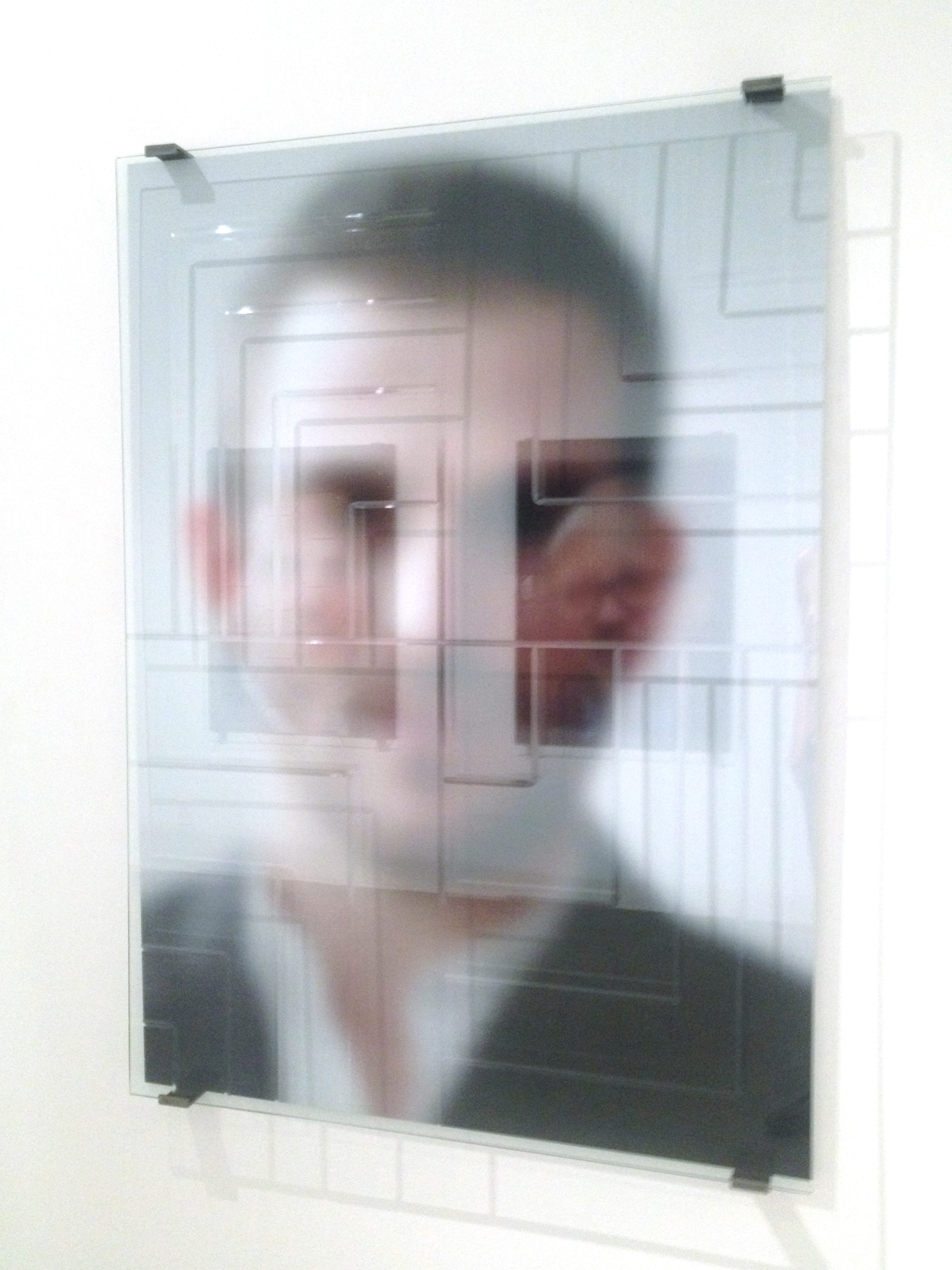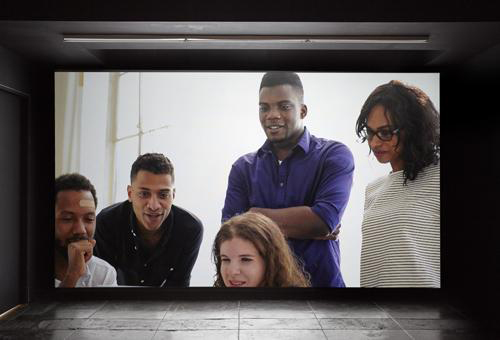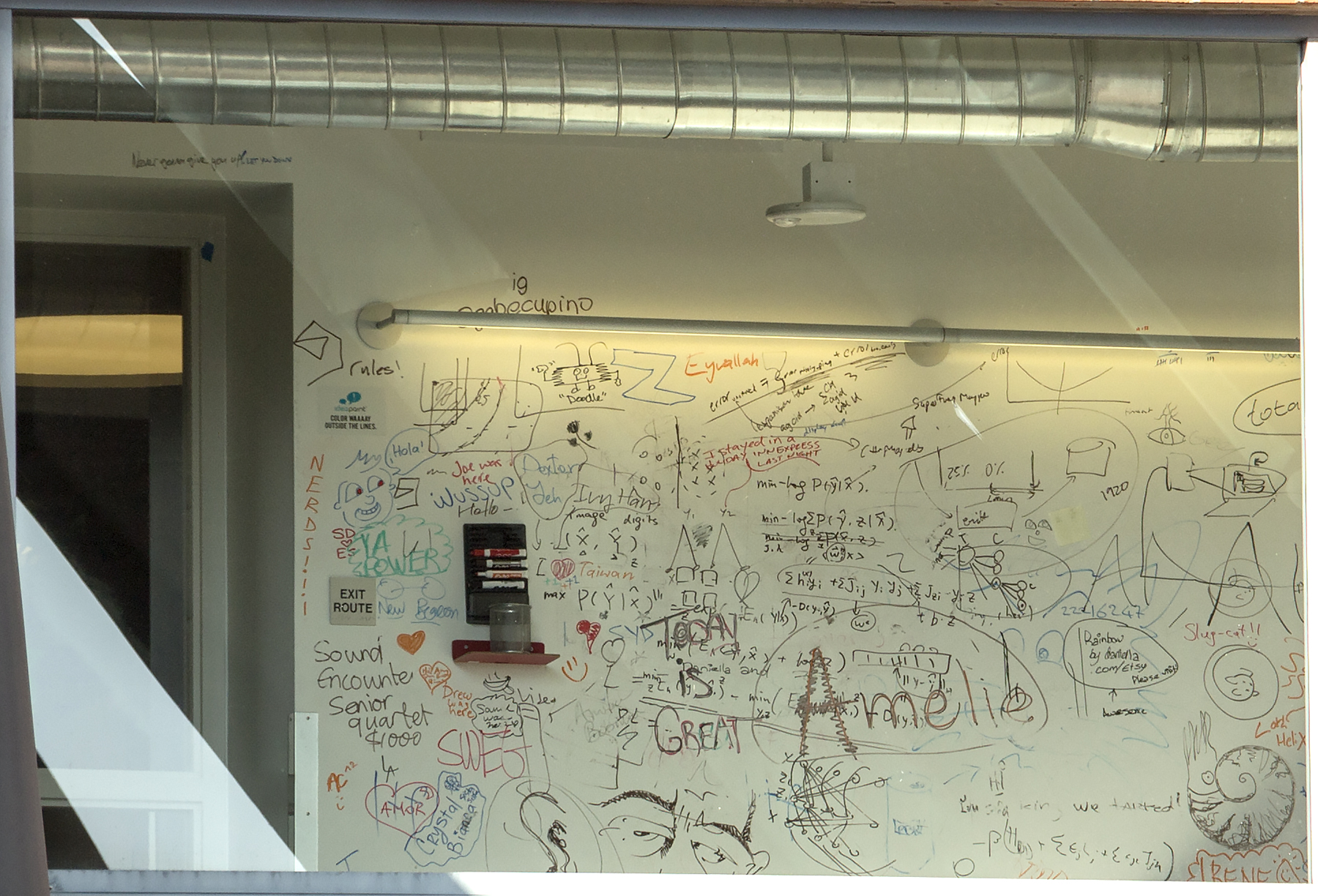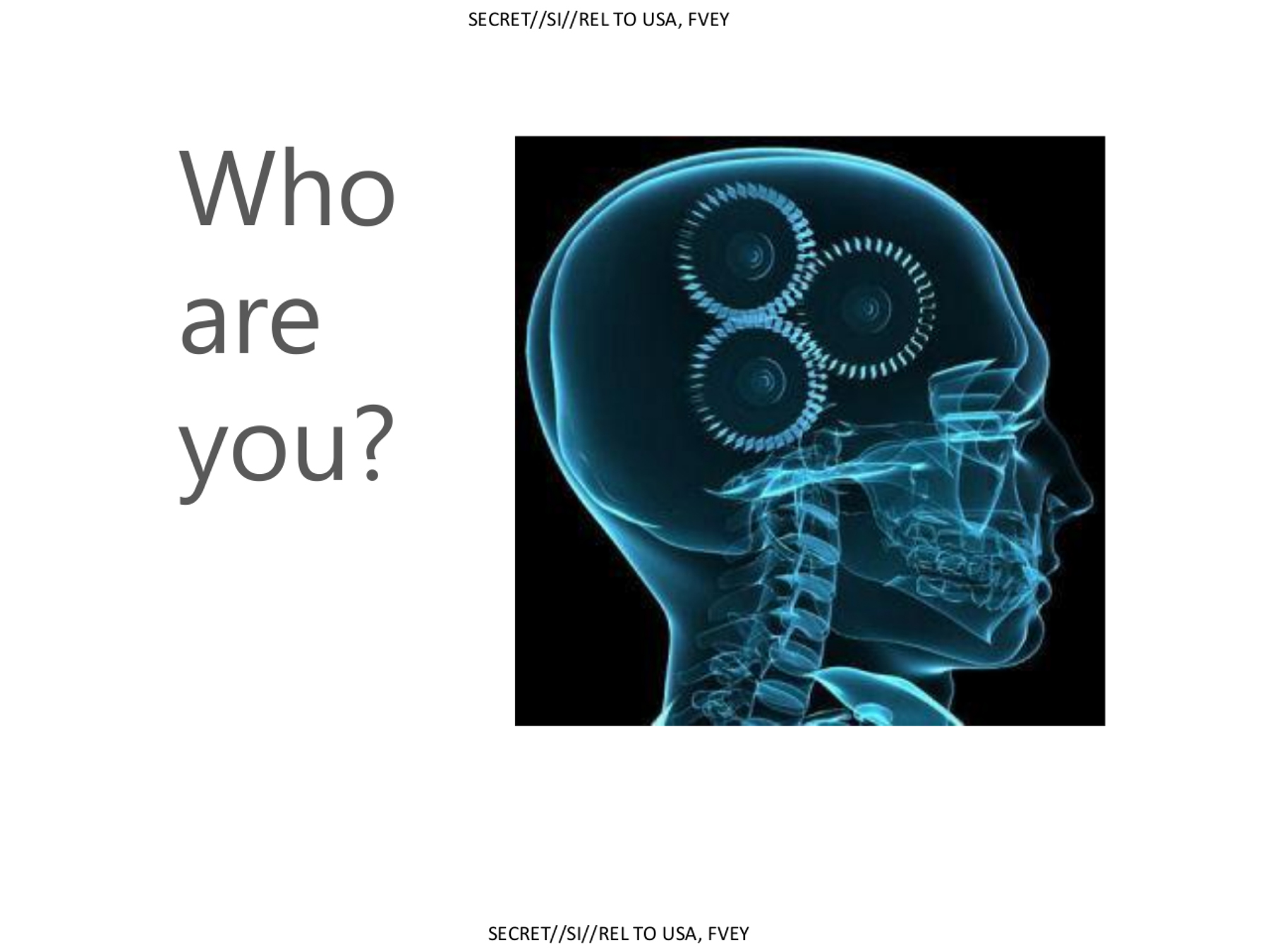Philip Seymour Hoffman died on February 2, 2014. Three days later, on Inside the Actor’s Studio, host James Lipton gave a curious eulogy: “We have him forever, thank heaven. But not long enough.”1 Television personality and actor Lipton, then 87, qualified actorly immortality as both endless and too short. Not long enough? Properly recorded and rebroadcast, via celluloid or codec, an actor might outlast death. An afterlife as image has its limits, of course—like those reached by the works in Then They Form Us at the Museum of Contemporary Art Santa Barbara. A 2014 video by Cécile B. Evans, Hyperlinks or it didn’t happen, titled after the meme, stars a gooey 3D-animated bust of “a famous actor” bearing unmistakable resemblance to the late Hoffman. Known for being two-dimensional—that is, a screen presence—Hoffman is here (roughly, perhaps fully) reincarnated. And he is disappointed with the results: “I’m not magic,” says the model, “and please don’t call me uncanny.” His plea is all the more pathetic for its echoes of aesthetic theory. The “uncanny valley,” a trough of revulsion on the graph from artifice to likeness, might account for what we reject as human, but not for what we accept as subject. “I’m just a bad copy,” continues the Hoffman avatar. “My voice is wrong. It’s not even connected to my face.” Never mind that a bad performance is said to lack depth. Such an imperfect rendering remains sufficient for a fixation on surface and visibility, the notched cues of subjecthood. Insofar as visibility constitutes existence, and not the other way around, the face is the thing.
Perhaps Hoffman remains a subject, but not a living one. Life still does contingency, interaction, and feedback better than life’s image. What is lost is the body, which, despite advances in media, remains the interface of subjectivity. Lipton might prefer what Evans’s avatar evokes: the Dixie Flatline from William Gibson’s Neuromancer, a toasted cyber jockey posthumously coded as software. Jacked into the crystal-laced black void of cyberspace, the Flatline’s meat-bound comrades can’t tell, though they know, he’s dead. The trick, perhaps, is to maintain an appearance (or manage a reappearance) worthy of Hannah Arendt: to fashion yourself as present in the public sphere—or, barring that, in whatever social media platform passes for the polis. Yet another of Evans’s narrators in Hyperlinks speaks to the dark side of media-augmented immortality. “My dead girlfriend,” says the voiceover, “keeps messaging me on Facebook.” She, or not-she, also begins tagging empty spaces in pictures where she “would have been.” A viewing public might make do with reruns, but for the loved one, the absence of the beloved’s body exceeds the reality of an image. After all, Arendt likens one’s appearance in the world not to starring in cinema, but to an actor walking on stage. Evans’s video plays on a monitor canted across a corner of the gallery, between two walls pasted with black wallpaper studded (code- or star-like) with graphics of dials, buttons, and rivets. A pair of headphones runs to a rug scattered with screen shots printed as four-by-six-inch photos. The video’s installation leans on physicality, despite itself; the image loops en abyme.2
Constant Dullaart’s 2012 video, Crystal Pillars, which played at the MCASB on a small screen, also alludes to the Facebook of the deceased. If life on Facebook has a deathly monotony, the dead there have a kind of life: their pages (“walls”), never deleted, become memorials. Dullaart compares this liminal status to the legendary “crystal pillars” of Ethiopia, which housed the deceased’s mummified bodies in the living rooms of their families.3 Facebook gives us some idea of how banal this glassed-in apparition might eventually become. Dullaart’s work counters cellphone footage of the artist hanging out IRL with a script read in voiceover by a woman who is audibly ill. The narrator recalls checking Facebook, email, news, and blogs—then only Facebook and email—back and forth. Waiting. For what? An appearance? Another “hit” of subjectivity? “I would refresh almost constantly,” she says, sniffling. Dullaart himself made for the exit in a 2012 performance, Terms of Service, in which he announced his Facebook password to a room full of strangers. Today the Constant Dullaart on FB is a conglomeration, a multiple personality. In Crystal Pillars, too, Dullaart has committed self-effacement; the voiceover actor performs a text that splices the artist’s words with, among others, statements by Mark Zuckerberg and the Facebook TOS. Yet “someone” persists: a spinoff Dullaart, a copy maintained by others.
In a side gallery, Dullaart presents a series of seven portraits of people who were, as the titles have it, Most likely involved in sales of intrusive privacy breaching software and hardware solutions to oppressive governments during so called Arab Spring (all works, 2014). Their faces are algorithmically blurred; above the mounted prints hover large panes of glass, etched with loose patterns of hexagons or stripes. The setup recalls what Facebook’s face-detect program might “detect,” gussied up as a fine art most wanted. Theirs are data crimes, image crimes; the “solutions” they most likely provided target the online selves of protesters. What is violated is precisely the responsibility that attends appearance in the public sphere. Rather than acknowledge and validate, such regimes use appearance against the appearers, as in the cataloging of dissidents by police. An embodied consequence might follow: harassment, prison time, or worse.

Cécile B. Evans, Hyperlinks or it didn’t happen, 2015. HD video, 22:30. Installation view, Then They Form Us, Museum of Contemporary Art Santa Barbara, 2015. Courtesy the Artist. Photo: Wayne McCall.
As Dullaart’s seven realize, it’s not what is sold, but to whom. Online platforms remain amoral. Accordingly, Google’s motto remains: “Don’t be evil.” Progressive/moral use of big data will follow first military and then corporate applications. Meanwhile, how do we visualize the back end of these proprietary archives of the self? A photo work by Julien Prévieux points a lens into a window of the former Chiat/Day building in Santa Monica, a Gehry effort famously colonnaded with a giant pair of binoculars by Coosje van Bruggen and Claus Oldenburg. Penetrating this vision-fixated façade reveals a whiteboard covered in marks, sacred and profane, made by the building’s present tenants: Google Inc. The “image work” of Prévieux is only able to penetrate a complex, consequential operation at the level of vision. It pulls from the palimpsest of math functions and doodles, or someone’s Etsy address, the more “comprehensible” moments: a drawing of a squid, the words “TODAY IS GREAT.” Most actionable intelligence, the real work, remains buried, either coded in a specialized language or, one imagines, on walls not visible through windows.

Constant Dullaart, Most likely involved in sales of intrusive privacy breaching software and hardware solutions to oppressive governments during so called Arab Spring (detail), 2014. Installation view, Then They Form Us, Museum of Contemporary Art Santa Barbara, 2015. Lamda print on dibond, encrypted message in jpg, hash-based authentication, custom brilliant-cut glass, brackets; 551⁄8 × 393⁄8 inches. All works courtesy the artist and Carroll/Fletcher Gallery, London, UK. Photo: Travis Diehl.
Devin Kenny’s LANyards (2015), a music video set in a whitewashed warehouse, makes a blunt parody of how mercenary an expanded “creativity” can be. As a group of smiling, vague professionals eat baby carrots and “work” on their “project,” the screen subdivides into picture-in-picture, and the upper right square flashes slides from a leaked British government Powerpoint on cyber security produced by British intelligence organization the Government Communications Headquarters (GCHQ). “We want to build Cyber Magicians,” reads one caption, below an image of two hands passing cards through the air. At clip’s end, in the translucent gray sans serif caps of a disclaimer, two rows of credits note “images courtesy Chelsea Manning.” True, this Powerpoint was part of the Snowden cache—though Manning, née Bradley, is a figure well positioned within the subjective polyvalence of this show. Issues of Internet security, the semantics of whistleblowing versus spying, and the definition of “aiding the enemy” flatten into the public image of Manning’s gender therapy, undergone while serving time in an army prison. Thus the twin righteous breaches—that of data and that of gender protocol—stand for a subjective malleability that, to paraphrase Paul B. Preciado, characterizes appearance in the pharmacopornographic era. Raps Kenny, the protagonist, in a kind of pep talk, “So if it’s free / best believe / you are the product.” The big tan Band-Aid pasted on his forehead is conspicuous.

Devin Kenny, LANyards, 2015. Video, 1:21 mins. From the album Alone We Play. Installation view. Courtesy the artist.
Put another way, our tools suggest their use. The technological appearance comes with a catch: given subjects must present themselves through a limited number of signs: a semiotic bandwidth. Prévieux’s 2014 video, What shall we do next? (Séquence #2), parodies the history of the natural user interface, or NUI. A group of dancers, making compulsive hand signals all the while, describes the rise and fall of various esoteric machine inputs. Their movements, if not patented themselves, derive from patented devices: coded sequences of scrolls, swipes, and clicks. Their dull clothes, the backdrop of earthy squares of paint, echo the deadened channels of relation, of desire, accessible mainly through “visible”—that is, well-marketed—interfaces.


Julien Prévieux, Today is Great, 2015. Color photographs, 3 × 5 inches each. Courtesy Jousse Entreprise Gallery, Paris, France.
This branch of thought reaches one underwhelming terminus in Xavier Cha’s Conductor (2015). For the work’s debut at MCASB, conductor Jonathan Tessero approached a music stand, then launched without fanfare—indeed, appearing not in conductors’ tails but dress-casual in a blue blazer and boot- cut jeans—into a silent rendition of a movement from Prokofiev’s Romeo and Juliet. Tessero doesn’t conduct an invisible orchestra so much as simply conduct. Yet he is also conducted: What direction has he received from Cha? What, in other words, is the full extent of the “codes” for a truncated display of romance? Such paratext matters when the surface is so tractionless; we would love for this appearance to conceal some actual relation—even a dull one.4
Hyperlinks or it didn’t happen. Pics used to be enough. But what proof can there be of the tiny charge-states of a website’s code, of the intricate census of subjecthood? Perhaps hyperlinks—beyond-links or links-beyond— offer a kind of cross-referential stability. Proof comes in the self-supporting relations of the ephemeral, the “link” or “click-hole,” reflected in the discursive style with which Evans’s video binds together heartbreaking tales from the Web within the cold nonexistence of the Dixie Flatline. For now, bodies in space remain the final (unscripted) manifestation of self. As with the consequences of Manning’s leak on her jailed body and the dissidents first imaged then disappeared by Dullart’s software dealers, a selfhood informed by the digital plays out, or outputs, IRL. The exhibition’s titular “they” nonetheless emerges, paranoically, as imbricated in an ulterior bracket of our subjecthood. If subjectivity depends on minor categories of data, and surface-based NUIs and GUIs are our only access, the show need only state the obvious to provoke the existential. Beyond the fields in a given (plat)form, the rest is a “mystery,” though not magic. First we create machines, “and then” the idea of progress, with our un-comprehended creations at the vanguard, curls back and offers us its form.

The Government Communications Headquarters, “The Art of Deception: Training for a New Generation of Online Covert Operations,” released in 2014. Slide presentation (excerpt).
Evans’s Hyperlinks includes a scene of Yowane Haku, a digitally animated pop star from Japan, performing Alphaville’s “Forever Young” (1984). Blessed by her software with eternal youth, stunning hair, and a well-rendered figure, Haku projects her soft power to millions of fans. Meanwhile, at a terminal across the sea, Jemma Pixie Hixon, an agorophobic British woman in her twenties, never leaves her house, yet is a YouTube and Instagram star. Will her fame withstand the invisibility of old age? Will her subjecthood? And/or will the Pixie Hixon of Web2.0 yet persist, independent, as a programmed self? Given options like these, do you really want to live forever? Celebrity is one thing. Appearance is another—one more healthily sustained by a fleshly reality. For celebrity, more essential is the void, tempered and formed by burning points of data like a Starfield screensaver. A diaphanous Haku sways in digital negligee in a 3D-modeled hotel room; a bottle labeled SOFTNESS sits on the nightstand; renderings of Monterey jellyfish crowd the window as if trolling in bluescreen.
“He’s a beautiful spirit,” said the actor Amy Adams of Philip Seymour Hoffman, appearing on Inside the Actor’s Studio. “And he had this unique ability to see people, to really see them. Not look through them. He just really saw people.”5“We have him forever, thank heaven,” said James Lipton.“But not long enough.”
Travis Diehl lives in Los Angeles. He is a recipient of the Creative Capital / Andy Warhol Foundation Arts Writers Grant. He serves on the editorial board of X-TRA Contemporary Art Quarterly and edits the artist-run arts journal Prism of Reality.
